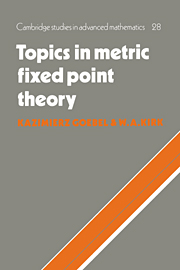Book contents
- Frontmatter
- Contents
- Preface
- 1 Preliminaries
- 2 Banach's Contraction Principle
- 3 Nonexpansive mappings: introduction
- 4 The basic fixed point theorems for nonexpansive mappings
- 5 Scaling the convexity of the unit ball
- 6 The modulus of convexity and normal structure
- 7 Normal structure and smoothness
- 8 Conditions involving compactness
- 9 Sequential approximation techniques for nonexpansive mappings
- 10 Weak sequential approximations
- 11 Properties of fixed point sets and minimal sets
- 12 Special properties of Hilbert space
- 13 Applications to accretivity
- 14 Ultrafilter methods
- 15 Set-valued mappings
- 16 Uniformly lipschitzian mappings
- 17 Rotative mappings
- 18 The theorems of Brouwer and Schauder
- 19 Lipschitzian mappings
- 20 Minimal displacement
- 21 The retraction problem
- Appendix: notes and comments
- References
- Index
4 - The basic fixed point theorems for nonexpansive mappings
Published online by Cambridge University Press: 21 October 2009
- Frontmatter
- Contents
- Preface
- 1 Preliminaries
- 2 Banach's Contraction Principle
- 3 Nonexpansive mappings: introduction
- 4 The basic fixed point theorems for nonexpansive mappings
- 5 Scaling the convexity of the unit ball
- 6 The modulus of convexity and normal structure
- 7 Normal structure and smoothness
- 8 Conditions involving compactness
- 9 Sequential approximation techniques for nonexpansive mappings
- 10 Weak sequential approximations
- 11 Properties of fixed point sets and minimal sets
- 12 Special properties of Hilbert space
- 13 Applications to accretivity
- 14 Ultrafilter methods
- 15 Set-valued mappings
- 16 Uniformly lipschitzian mappings
- 17 Rotative mappings
- 18 The theorems of Brouwer and Schauder
- 19 Lipschitzian mappings
- 20 Minimal displacement
- 21 The retraction problem
- Appendix: notes and comments
- References
- Index
Summary
We have already seen that some bounded, closed and convex sets K in certain Banach spaces have the property that every nonexpansive self-mapping T: K→K must have a fixed point. When this is the case we say that K has the fixed point property (f.p.p.) for nonexpansive mappings and, if it is clear that only nonexpansive mappings are being considered, we shall simply say that K has the fixed point property or that K has f.p.p. Also, unless otherwise specified, we shall always assume that K is nonempty, bounded, closed and convex.
The problem of determining conditions on K (or on the space X containing K) which always insure that K has the f.p.p. has its origins in four papers which appeared in 1965. In the first of these (Browder, 1965a), F. Browder proved that a bounded, closed, convex set K ⊂ X has f.p.p. if X is a Hilbert space. Almost immediately, both Browder (1965b) and Göhde (1965) proved that the same is true if X belongs to the much wider class of ‘uniformly convex’ spaces (discussed in the next chapter). At the same time Kirk (1965) observed that the presence of a geometric property called ‘normal structure’ guarantees that K ⊂ X has f.p.p. if X is reflexive. The concept of normal structure was introduced in 1948 by Brodskii and Milman (1948) to study fixed points of isometries, and it is a property shared by all uniformly convex spaces.
- Type
- Chapter
- Information
- Topics in Metric Fixed Point Theory , pp. 37 - 50Publisher: Cambridge University PressPrint publication year: 1990



